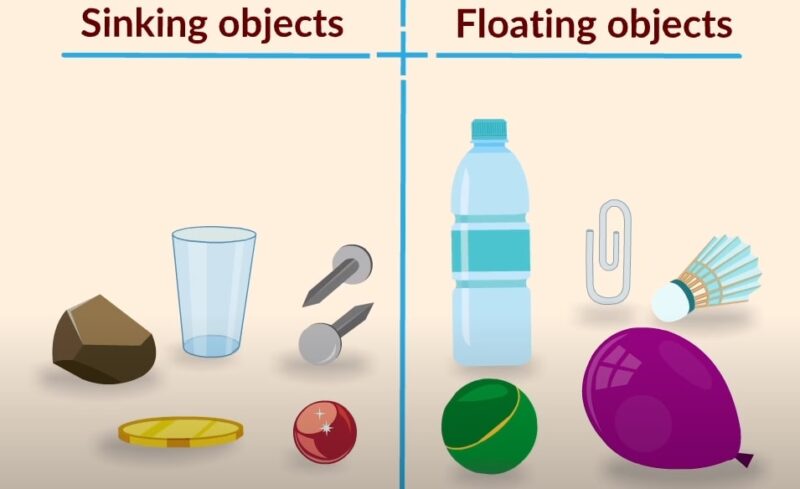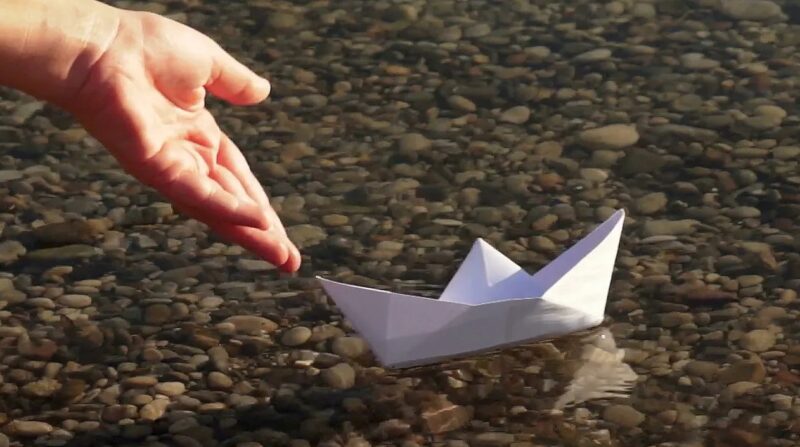When an object is submerged in water, it displaces a volume of the fluid, which in turn exerts an upward buoyant force on the object. This force is described by Archimedes’ principle, which states that the buoyant force on an object is equal to the weight of the fluid displaced by the object.
Density, defined as mass per unit volume, is a crucial factor in determining an object’s buoyancy. For instance, a solid steel object will sink due to its high density, whereas a steel ship can float because its design ensures it displaces enough water to create a sufficient buoyant force.
This article explores the scientific principles behind buoyancy and density, offering a detailed explanation of why objects float or sink.
Density and Buoyancy
Density is crucial in determining whether an object will float or sink in water. Defined as mass per unit volume, density indicates how much matter is packed into a given space.
Density Explained

The density of an object is calculated by dividing its mass by its volume. This determines how tightly matter is packed within the object.
Buoyancy and Density Relationship
When an object is placed in water, it experiences an upward buoyant force. According to Archimedes’ principle, this force equals the weight of the water displaced by the object. Whether an object floats or sinks depends on its density relative to water, which has a density of 1 g/cm³.
- Floating: Objects with a density less than water will float. For example, wood, which typically has a density of around 0.5 g/cm³, floats because the buoyant force is greater than its weight.
- Sinking: Objects with a density greater than water will sink. A steel ball, with a much higher density, sinks because its weight exceeds the buoyant force acting on it.
Archimedes’ Principle
Archimedes’ principle is a fundamental law of physics that states that any object completely or partially submerged in a fluid is buoyed up by a force equal to the weight of the fluid displaced by the object. This principle explains why objects appear lighter in water and why they float or sink based on the volume of water they displace.
When an object is placed in water, it pushes the water out of the way, creating a displaced volume. The weight of this displaced water is equal to the buoyant force acting on the object. If the weight of the displaced water is equal to or greater than the weight of the object, the object will float. If it is less, the object will sink.

Buoyant Force vs. Gravitational Force
Two primary forces acting on an object when it is submerged in a fluid: buoyant force and gravitational force.
- Buoyant Force: This force is equal to the weight of the fluid displaced by the object. It acts in the opposite direction to gravity and is responsible for making objects feel lighter in water.
- Gravitational Force: This force is the weight of the object, acting downward due to gravity.
An object will float if the buoyant force is equal to or greater than the gravitational force acting on it. Conversely, if the gravitational force exceeds the buoyant force, the object will sink.

Water Displacement
Water displacement is the key concept behind buoyancy. When an object is submerged in water, it displaces a volume of water equal to the volume of the object that is submerged. This displaced water exerts an upward buoyant force on the object.
For example, if you place a solid block of metal in water, it will displace an amount of water equal to its volume. The weight of this displaced water creates an upward force that opposes the weight of the metal block. If the weight of the displaced water is greater than the weight of the block, the block will float. If it is less, the block will sink.
Submarines, for instance, control their buoyancy by adjusting the amount of water in their ballast tanks, allowing them to sink or rise in the water.
Real-World Examples

Buoyancy principles are widely used in various fields and applications:
- Ships and Boats: Ships and boats are designed to displace enough water to create a buoyant force that keeps them afloat. The shape and volume of the hull ensure that the vessel displaces sufficient water to counteract its weight.
- Submarines: Submarines adjust their buoyancy by controlling the amount of water in their ballast tanks. By taking in water, they increase their density and sink. By expelling water, they decrease their density and rise to the surface.
- Hot Air Balloons: Hot air balloons float because the hot air inside the balloon is less dense than the cooler air outside. The buoyant force created by the displaced cooler air lifts the balloon.
Factors Influencing Buoyancy
Several factors influence an object’s buoyancy in water:
- Density: The density of the object relative to the density of water is the most critical factor. Objects with a lower density than water will float, while those with a higher density will sink.
- Shape and Volume: The shape and volume of an object affect how much water it displaces and, consequently, the buoyant force acting on it. Objects with larger volumes displace more water and experience greater buoyant forces.
- Fluid Density: The density of the fluid in which the object is submerged also plays a role. In denser fluids, objects are more likely to float because the buoyant force is greater.
Floating and Sinking Objects

Objects can be categorized based on their ability to float or sink in water:
- Floating Objects: Objects like wood, ice, and certain plastics float because their densities are lower than that of water. They displace enough water to create a buoyant force that supports their weight.
- Sinking Objects: Objects like metal, stone, and dense plastics sink because their densities are higher than that of water. They do not displace enough water to counteract their weight.
Shape and Volume
The shape and volume of an object significantly impact its buoyancy:
- Shape: The shape of an object can affect how much water it displaces. For example, a flat, wide object will displace more water than a narrow, compact object of the same volume.
- Volume: The volume of an object determines how much water it can displace. Larger objects displace more water and, therefore, experience greater buoyant forces.
Designing objects with specific shapes and volumes can enhance their buoyancy, allowing them to float even if they are made of dense materials.
Common Misconceptions
There are several common misconceptions about buoyancy:
- Depth: Some people believe that the buoyant force increases with depth. However, the buoyant force is determined by the volume of displaced fluid, not the depth at which the object is submerged.
- Weight: Another misconception is that heavier objects cannot float. In reality, an object’s ability to float depends on its density relative to the fluid, not just its weight.
Conclusion
Understanding why objects float or sink when placed on the surface of water involves comprehending the principles of buoyancy, density, and water displacement. These principles are fundamental in various scientific and engineering applications, from designing ships to exploring underwater environments.
By analyzing the factors influencing buoyancy and dispelling common misconceptions, we can gain a clearer understanding of this fascinating physical phenomenon.

